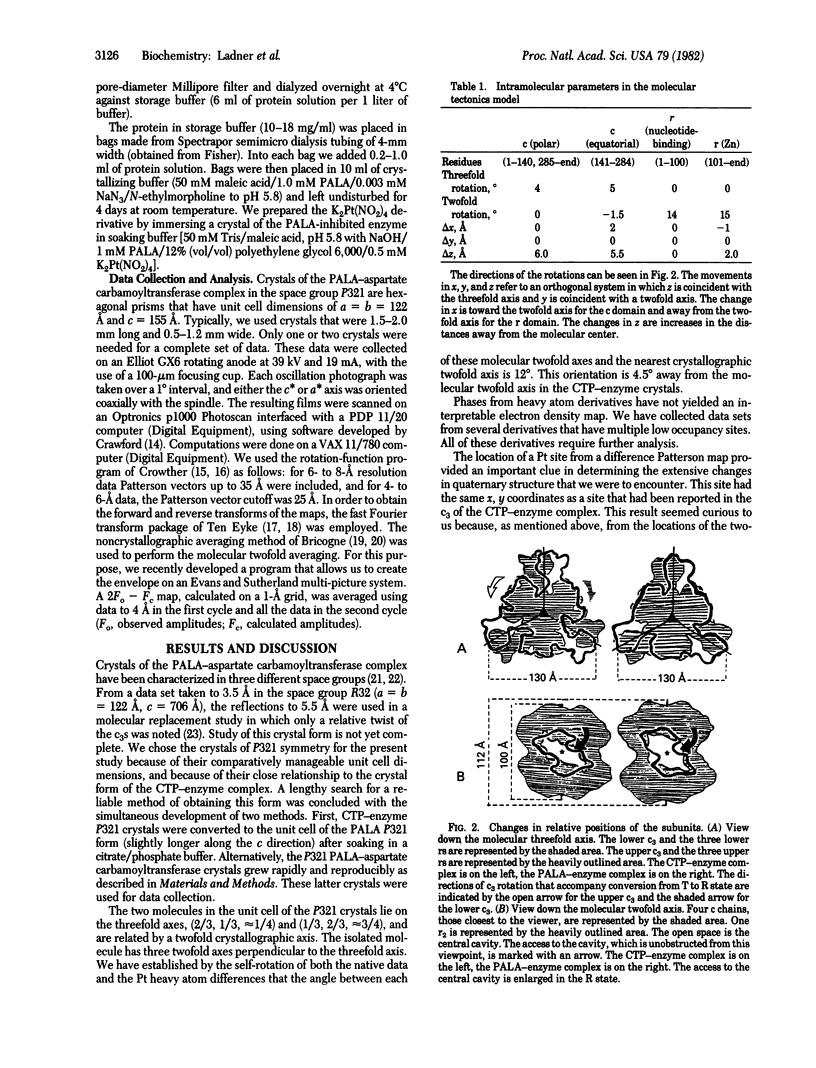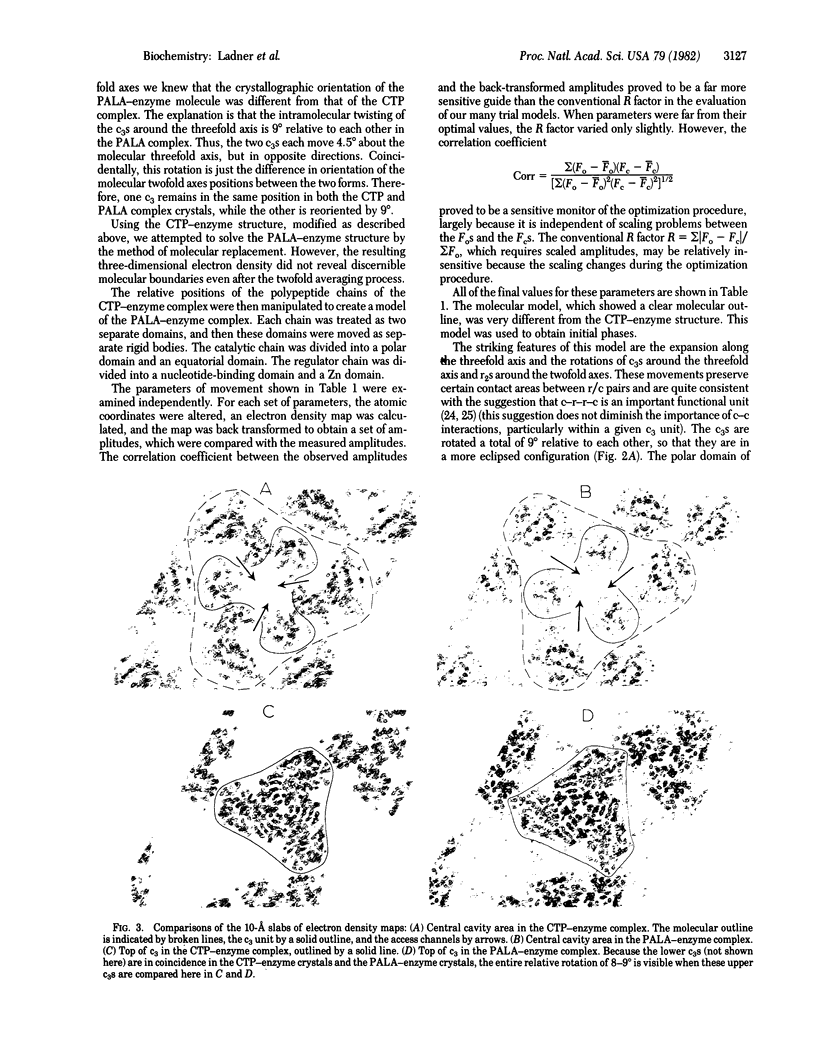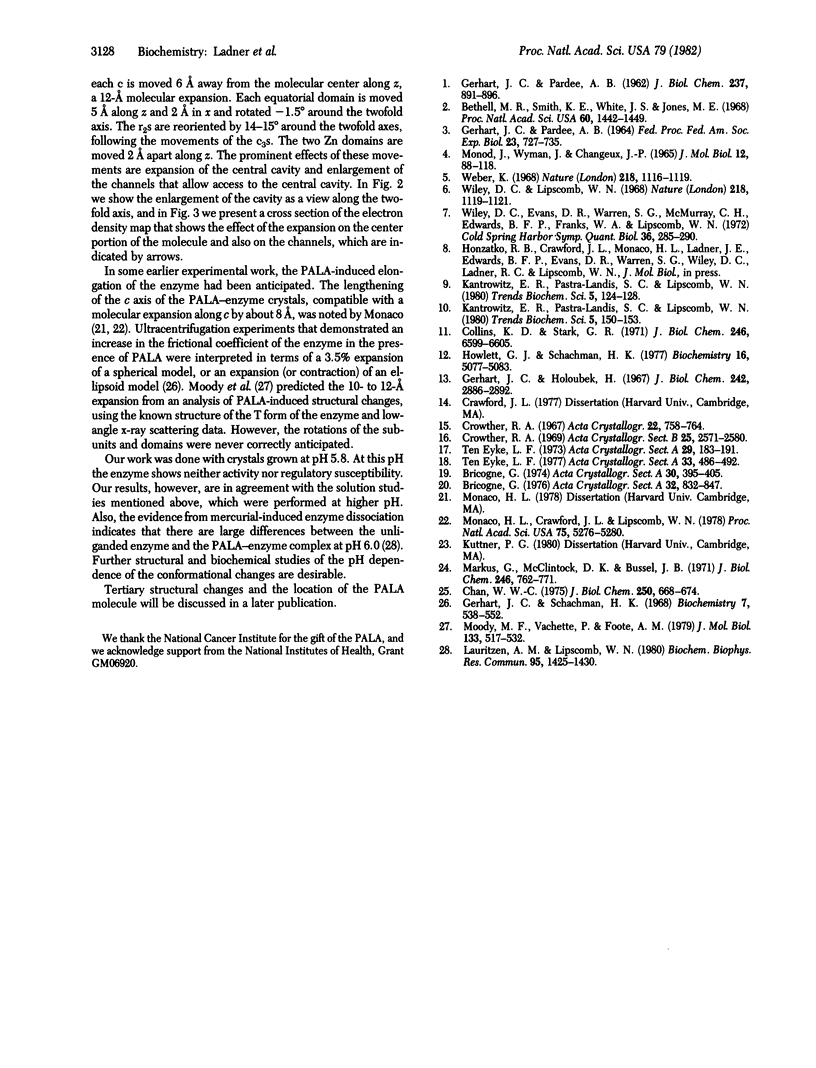Abstract
The three-dimensional structure of the complex of N-(phosphonacetyl)-L-aspartate with aspartate carbamoyltransferase (carbamoylphosphate:L-aspartate carbamoyltransferase, EC 2.1.3.2) has been determined to a nominal resolution of 3.5 A by single-crystal x-ray diffraction methods. Initial phases were obtained by the method of "molecular tectonics": beginning with the structure of the CTP-protein complex, the domains of the catalytic and regulatory chains were manipulated as separate rigid bodies. The resulting coordinates were used to calculate an electron density map, which was then back transformed to give a set of calculated amplitudes and phases. Using all observed data, we obtained a crystallographic R factor between observed and calculated amplitudes Fo and Fc of 0.46. An envelope was then applied to a 2Fo - Fc map and the density was averaged across the molecular twofold axis. Two cycles of averaging yielded an R factor of 0.25. In this complex, we find that the two catalytic trimers have separated from each other along the threefold axis by 11-12 A and have rotated in opposing directions around the threefold axis such that the total relative reorientation is 8-9 degrees. This rotation places the trimers in a more nearly eclipsed configuration. In addition, two domains in a single catalytic chain have changed slightly their spatial relationship to each other. Finally, the two chains of one regulatory dimer have rotated 14-15 degrees around the twofold axis, and the Zn domains have separated from each other by 4 A along the threefold axis. These movements enlarge the central cavity of the molecule and allow increased accessibility to this cavity through the six channels from the exterior surface of the enzyme.
Full text
PDF



Images in this article
Selected References
These references are in PubMed. This may not be the complete list of references from this article.
- Bethell M. R., Smith K. E., White J. S., Jones M. E. Carbamyl phosphate: an allosteric substrate for aspartate transcarbamylase of Escherichia coli. Proc Natl Acad Sci U S A. 1968 Aug;60(4):1442–1449. doi: 10.1073/pnas.60.4.1442. [DOI] [PMC free article] [PubMed] [Google Scholar]
- Chan W. W. Subunit interactions in aspartate transcarbamylase. A model for the allosteric mechanism. J Biol Chem. 1975 Jan 25;250(2):668–674. [PubMed] [Google Scholar]
- Collins K. D., Stark G. R. Aspartate transcarbamylase. Interaction with the transition state analogue N-(phosphonacetyl)-L-aspartate. J Biol Chem. 1971 Nov;246(21):6599–6605. [PubMed] [Google Scholar]
- Crowther R. A. The use of non-crystallographic symmetry for phase determination. Acta Crystallogr B. 1969 Dec 15;25(12):2571–2580. doi: 10.1107/s0567740869006091. [DOI] [PubMed] [Google Scholar]
- GERHART J. C., PARDEE A. B. ASPARTATE TRANSCARBAMYLASE, AN ENZYME DESIGNED FOR FEEDBACK INHIBITION. Fed Proc. 1964 May-Jun;23:727–735. [PubMed] [Google Scholar]
- GERHART J. C., PARDEE A. B. The enzymology of control by feedback inhibition. J Biol Chem. 1962 Mar;237:891–896. [PubMed] [Google Scholar]
- Gerhart J. C., Holoubek H. The purification of aspartate transcarbamylase of Escherichia coli and separation of its protein subunits. J Biol Chem. 1967 Jun 25;242(12):2886–2892. [PubMed] [Google Scholar]
- Gerhart J. C., Schachman H. K. Allosteric interactions in aspartate transcarbamylase. II. Evidence for different conformational states of the protein in the presence and absence of specific ligands. Biochemistry. 1968 Feb;7(2):538–552. doi: 10.1021/bi00842a600. [DOI] [PubMed] [Google Scholar]
- Howlett G. J., Schachman H. K. Allosteric regulation of aspartate transcarbamoylase. Changes in the sedimentation coefficient promoted by the bisubstrate analogue N-(phosphonacetyl)-L-aspartate. Biochemistry. 1977 Nov 15;16(23):5077–5083. doi: 10.1021/bi00642a021. [DOI] [PubMed] [Google Scholar]
- Lauritzen A. M., Lipscomb W. N. Effect of pH on local and gross conformational changes in aspartate transcarbamylase. Biochem Biophys Res Commun. 1980 Aug 29;95(4):1425–1430. doi: 10.1016/s0006-291x(80)80056-8. [DOI] [PubMed] [Google Scholar]
- MONOD J., WYMAN J., CHANGEUX J. P. ON THE NATURE OF ALLOSTERIC TRANSITIONS: A PLAUSIBLE MODEL. J Mol Biol. 1965 May;12:88–118. doi: 10.1016/s0022-2836(65)80285-6. [DOI] [PubMed] [Google Scholar]
- Markus G., McClintock D. K., Bussel J. B. Conformational changes in aspartate transcarbamylase. 3. A functional model for allosteric behavior. J Biol Chem. 1971 Feb 10;246(3):762–771. [PubMed] [Google Scholar]
- Monaco H. L., Crawford J. L., Lipscomb W. N. Three-dimensional structures of aspartate carbamoyltransferase from Escherichia coli and of its complex with cytidine triphosphate. Proc Natl Acad Sci U S A. 1978 Nov;75(11):5276–5280. doi: 10.1073/pnas.75.11.5276. [DOI] [PMC free article] [PubMed] [Google Scholar]
- Moody M. F., Vachette P., Foote A. M. Changes in the x-ray solution scattering of aspartate transcarbamylase following the allosteric transition. J Mol Biol. 1979 Oct 9;133(4):517–532. doi: 10.1016/0022-2836(79)90405-4. [DOI] [PubMed] [Google Scholar]
- Weber K. New structural model of E. coli aspartate transcarbamylase and the amino-acid sequence of the regulatory polypeptide chain. Nature. 1968 Jun 22;218(5147):1116–1119. doi: 10.1038/2181116a0. [DOI] [PubMed] [Google Scholar]
- Wiley D. C., Evans D. R., Warren S. G., McMurray C. H., Edwards B. F., Franks W. A., Lipscomb W. N. The 5.5 Angstrom resolution structure of the regulatory enzyme, asparate transcarbamylase. Cold Spring Harb Symp Quant Biol. 1972;36:285–290. doi: 10.1101/sqb.1972.036.01.038. [DOI] [PubMed] [Google Scholar]
- Wiley D. C., Lipscomb W. N. Crystallographic determination of symmetry of aspartate transcarbamylase. Nature. 1968 Jun 22;218(5147):1119–1121. doi: 10.1038/2181119a0. [DOI] [PubMed] [Google Scholar]






